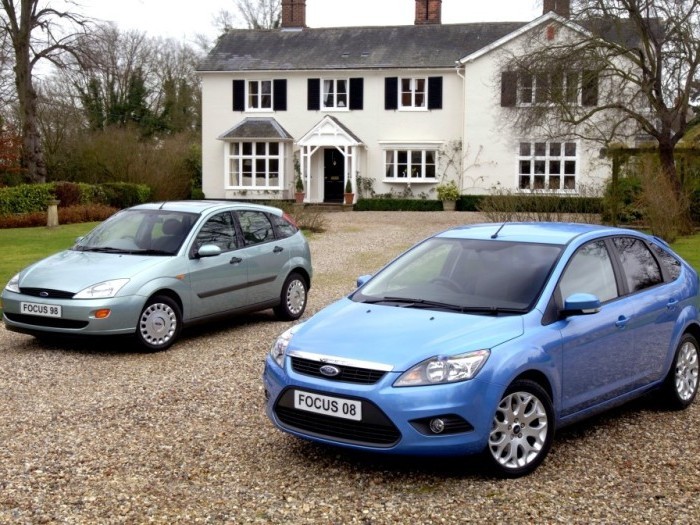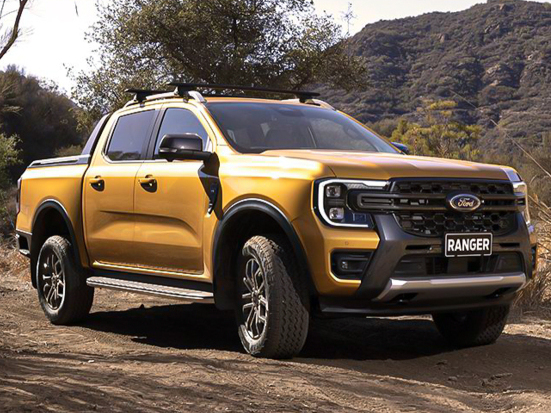Q
Does Ford Focus have high fuel efficiency?
The official combined fuel consumption of the 2017 Ford Focus sedan 1.5-liter EcoBoost Premium+ is 5.6 liters per 100 kilometers, which indicates that it can be considered fuel-efficient to a certain extent. However, the actual fuel consumption may vary. Driving habits play a significant role. For example, an aggressive driving style with frequent rapid acceleration and hard braking will consume more fuel, while smooth and constant-speed driving helps achieve better fuel economy. Road conditions are also important; compared to driving at a steady speed on the highway, stop-and-go traffic in the city usually leads to higher fuel consumption. In addition, vehicle load, tire pressure, and proper vehicle maintenance such as timely oil changes can also affect fuel efficiency. Overall, although the official data shows that this Ford Focus has good fuel-saving potential, various factors can influence its actual fuel consumption.
Special Disclaimer: This content is published by users and does not represent the views or position of PCauto.
Related Q&A
Q
What's the fuel consumption of Ford Focus?
The official combined fuel consumption of the 2017 Ford Focus 4-door sedan with a 1.5-liter EcoBoost engine, Titanium Plus Edition, is 5.6 liters per 100 kilometers. This figure is measured under specific test conditions stipulated by the manufacturer. However, in real-world driving, the actual fuel consumption can vary due to multiple factors.
For instance, driving style has a significant impact on fuel consumption. An aggressive driving style with frequent rapid acceleration and hard braking usually leads to higher fuel consumption, while smooth and constant-speed driving helps save fuel. Road conditions also play a role. Compared with driving on a flat highway with light traffic, driving on hills or in heavy traffic typically increases fuel consumption.
In addition, vehicle load, tire pressure, and the use of accessories such as the air - conditioning system can all affect the actual fuel consumption of the Ford Focus.
Q
What's the service life of Ford Focus' petrol engine?
The service life of the gasoline engine in the Ford Focus can be different. Generally speaking, if properly maintained, the service life of gasoline engine can last for more than 150,000 to 200,000 miles (about 240,000 to 320,000 kilometers) or even longer. The Ford Focus 1.5 EcoBoost Titanium+ is equipped with a 1498 - cc gasoline engine.
Regular oil changes are crucial because fresh oil lubricates the engine components, reducing friction and wear. Replacing filters, such as the air filter and fuel filter, also enables the engine to take in clean air and get the proper fuel mixture. Timely replacement of belts and hoses that age over time helps prevent unexpected breakdowns. Maintaining good driving habits is also important. Aggressive driving with sudden acceleration and hard braking will damage the engine, while smooth driving can extend the engine's service life. Additionally, following the manufacturer's maintenance schedule for the engine (for the Ford Focus, it might be maintenance at regular intervals of mileage or time) can ensure the engine stays in good working condition over the long term.
Q
Which one is better, Honda Civic or Ford Focus?
The Honda Civic and the Ford Focus each have their own advantages, making it difficult to simply judge which one is better. In terms of appearance, the front end of the Ford Focus has a dynamic design. Its large - sized aluminum alloy wheels are well - matched with the sporty taillight group, giving the car an overall fashionable and tech - savvy look. On the other hand, the Honda Civic may have a more simple and smooth shape.
When it comes to the interior, the Focus' 13.2 - inch floating central control screen creates an excellent technological atmosphere. It also comes with a large - sized sunroof, automatic air - conditioning and other complete configurations. The Civic's interior perhaps focuses more on the balance between comfort and practicality.
In terms of power, the Focus offers a variety of power options, including different turbocharged engines, providing plenty of driving fun. The Civic's power performance can also meet the needs of daily driving, and it may perform well in terms of fuel economy.
The prices of the two cars also vary depending on the specific models and configurations. It is recommended that you go to a dealership to test - drive these two models in person, experience their actual driving feelings, and then select the most suitable model for yourself based on factors such as your budget and your preferences for the appearance and interior.
Q
Is Ford Focus smaller than Corolla?
The 2017 Ford Focus Sedan 1.5 EcoBoost Titanium+ measures 4,534mm in length, 1,823mm in width, and 1,484mm in height, with a wheelbase of 2,648mm. The dimensions of the Corolla vary depending on the version and year. Generally, its length ranges from 4,300mm to 4,600mm, width from 1,700mm to 1,800mm, height from 1,450mm to 1,500mm, and wheelbase typically from 2,600mm to 2,700mm. As we can see, the Ford Focus is bigger than the common Corolla in length, width, height, and also longer in wheelbase.
However, the interior space of a car isn't solely determined by its exterior dimensions. Factors such as the in - car layout design also play a role in the actual space experience. Moreover, there are differences in the dimensions among different Corolla models. A detailed comparison requires the accurate parameters of the actual models. But when compared with the above - mentioned models, the Ford Focus has larger overall dimensions.
Q
Which one is better, Mazda 3 or Ford Focus?
Both Mazda 3 and Ford Focus have their own advantages, so which one is better depends on individual needs and preferences. In terms of price, if you have a limited budget, the Focus might be more suitable as it is relatively affordable. When it comes to configuration, the Mazda 3 has more abundant safety features. Even the base - model is equipped with a tire pressure monitoring system and a vehicle stability control system. Regarding power performance, the Focus is powered by a 1.5 - liter naturally - aspirated engine, while the Mazda 3 offers a choice between a 1.5L and a 1.4T engine, and the 1.4T engine provides stronger power. In terms of exterior design, the Focus has a more masculine look, while the Mazda 3 is more appealing to women. Moreover, the seams on the Mazda 3's center console are more delicate. In terms of space, some testers think that the Mazda 3 has a slight edge in headroom and legroom. All in all, if you focus on price and practicality, the Focus is a good option. However, if you prefer rich configurations and strong power, the Mazda 3 may be a better choice.
Q
What is the fuel economy of Ford Focus?
The official fuel consumption of the 2017 Ford Focus sedan 1.5-liter EcoBoost Titanium Plus Edition is 5.6 liters per 100 kilometers. This figure represents the combined fuel consumption under standard test conditions. In real-world driving, the fuel consumption may vary, which can be affected by factors such as driving style, road conditions, and vehicle load. For example, an aggressive driving style with rapid acceleration and hard braking may increase fuel consumption, while a smoother and more stable driving style may make the actual fuel consumption closer to the official data. Additionally, using features such as the air conditioner and having an excessive vehicle load can also affect the car's fuel consumption. The Focus's fuel consumption of 5.6 liters per 100 kilometers makes it a relatively fuel-efficient model in the compact car segment, helping car owners reduce their vehicle usage costs.
Q
Which model of Ford Focus is the best?
As the criteria for "the best" vary from different people, so it's quite difficult to directly determine which model is the best. Take the 2017 Ford Focus Sedan 1.5 EcoBoost Titanium+ as an example. It is equipped with rich configurations. In terms of power, the 1.5 - liter engine has a maximum horsepower of 182PS. The maximum speed can reach 222km/h, and it can accelerate from 0 to 100km/h in 8.6 seconds. Its power output has certain advantages among cars in the same class. Regarding safety features, it is standard - equipped with a series of safety systems such as ABS anti - lock brakes, vehicle stability control, and lane - change assist, and also has six airbags to comprehensively ensure the safety of drivers and passengers. There are also quite a few comfort features inside the car, like the dual - zone automatic air - conditioning in the front row and Sony speakers. However, if consumers pay more attention to fuel economy, its official combined fuel consumption of 5.6L/100km is quite good. If they prefer space, its 421L trunk volume is just average. So, the best model depends on individual's preferences.
Q
Is Ford Focus a small or mid-size car?
The Ford Focus is a small car, specifically a C-segment or compact sedan. It has a body length of 4,534 millimeters, a width of 1,823 millimeters, a height of 1,484 millimeters, and a wheelbase of 2,648 millimeters. These dimensions are typical specifications for a compact sedan. In the automotive classification, compared with mid-size or large vehicles, compact sedans are known for their relatively small size, which makes them easier to be driven in the city.
Compact sedans like the Ford Focus are popular among many consumers for their affordable price, good fuel economy, and easy parking. The Ford Focus is an excellent choice for daily commuting and city driving. And as a compact sedan, it also offers an ample interior space and features, such as a 55-liter fuel tank and 421 liters of trunk space.
Q
How far can a Ford Focus travel on an empty fuel tank?
Generally speaking, it's not recommended to drive your car until the fuel runs out completely, as this can potentially damage components like the fuel pump. However, in theory, if we estimate based on the information of the 2017 Ford Focus Sedan 1.5 EcoBoost Titanium+, its fuel tank capacity is 55 liters, and the official combined fuel consumption is 5.6 liters per 100 kilometers. Calculated at this fuel - consumption level, the theoretical driving range of this car when the tank is full is about 982 kilometers.
However, the actual range is affected by various factors. For example, driving style is an important factor. Frequent hard acceleration and sudden braking increase fuel consumption and reduce the range. Road conditions also play a role. Driving in congested traffic or on mountain roads can cause the fuel consumption to go up. Vehicle load is another factor. Having more passengers or carrying a large amount of items in the car will make it "thirstier" for fuel. So, in actual use, the range of this car will be less than the theoretical value, and the specific figure depends on the actual driving conditions.
Q
What is special about Ford Focus?
The Ford Focus has many distinctive features. It is equipped with a 1.5-liter EcoBoost engine that strikes a great balance between performance and efficiency. The maximum speed can reach up to 222 km/h, and the official 0 - 100 km/h acceleration time is 8.6 seconds. Meanwhile, the official combined fuel consumption is relatively low, at 5.6 liters per 100 kilometers.
In terms of safety, it is equipped with a series of standard features, such as six airbags, an Anti-lock Braking System (ABS), a Vehicle Stability Control system, and a variety of active safety systems. Comfort and convenience are also well - guaranteed. It offers a dual - zone automatic air - conditioning system and a Sony audio system for the front row, along with keyless operation and a single sunroof.
The interior design focuses on ergonomics, creating a "flight cockpit" feel. The 60:40 split - folding rear seats enhance the vehicle's practicality. Moreover, the exterior features a modern and dynamic design with sharp lines, which has won the favor of many consumers.
Popular Cars
Model Year
Car Compare
Car Photo
Latest Q&A
Q
How much does it cost to buy a 2024 Tesla Model 3?
The 2024 Tesla Model 3 starts at around RM 175,000, but the final price depends on your chosen configuration and add-ons. Opt for the Long Range or Performance version, and you’re looking at a higher tag.
As Tesla’s entry-level model, it packs cutting-edge EV tech, including 500+ km of range on a single charge and standard Autopilot for both daily commutes and road trips. Just keep in mind extra costs like insurance, registration, and potential home charger installation.
Tesla’s Supercharger network is expanding locally, with solid coverage in major cities, making charging hassle-free. Maintenance costs? Typically lower than gas cars—no oil changes, fewer moving parts—so long-term savings add up.
If you’re after more thrills, the Performance variant hits 0-100 km/h in roughly 3 seconds. Plus, government EV tax perks help soften the upfront cost.
Q
How reliable is the 2024 Model 3?
The 2024 Model 3 delivers solid reliability, thanks to Tesla’s continuous software updates and hardware refinements. Key areas like the battery management system and Autopilot have seen multiple optimizations, leading to a noticeable drop in failure rates.
This model features a stiffer body structure and an improved suspension setup, offering a smoother ride. Upgraded interior materials also help reduce cabin rattles—a common gripe with earlier builds.
EV maintenance costs remain low (no oil changes, etc.), though it’s wise to periodically check battery health and charging components for long-term performance. For shoppers eyeing EVs, charging infrastructure and home charging options matter—thankfully, public chargers are expanding fast, making daily use more convenient.
If you frequently road-trip, planning charging stops ahead helps. While the range easily handles daily drives, a little route prep goes a long way in maximizing the experience.
Q
What is the battery range of the Tesla Model 3 2025?
The battery range of Tesla Model 3 2025 is expected to be optimized based on existing models, and specific data needs to be released officially. However, referring to the EPA range of the 2024 rear wheel drive version, which is about 438 kilometers, and the high-performance version, which is about 513 kilometers, the 2025 model may further improve, especially in terms of battery technology or energy efficiency management. For electric vehicles, the range is greatly affected by driving habits, road conditions, and climate. Air conditioning may slightly reduce the range in hot weather, but the battery thermal management system can usually maintain stable performance. In terms of charging, Model 3 supports super fast charging, which can replenish about 250 kilometers of range in about 15 minutes, while home charging stations require 6-8 hours to fully charge. Daily commuting or long-distance travel are practical enough, it is recommended to follow Tesla's official website or local showroom for the latest information.
Q
Is the 2024 Model 3 worth the price?
The 2024 Model 3 strikes an impressive balance between price and performance. Its upgraded range, more refined interior, and enhanced autonomous driving features genuinely boost its competitiveness—especially for tech-savvy, eco-conscious buyers.
Tesla optimized the battery efficiency this time around, making it suitable for both daily commutes and longer trips, while the handling stays true to the brand’s signature responsiveness. If your budget allows and you’re open to EVs, this one’s worth considering—though a test drive is wise to see if it matches your driving style.
That said, local charging access matters. While public chargers are becoming more common, home installation costs should factor into your budget. Alternatives in this price range exist, so cross-shop specs and service policies (like warranty coverage or charging network support) to make a well-rounded decision.
Q
How many miles does a 2024 Tesla Model 3 get?
The 2024 Tesla Model 3 offers varying range figures depending on configuration. The rear-wheel-drive (RWD) version delivers an EPA-estimated 272 miles (approx. 438 km), while the all-wheel-drive Long Range model pushes that to around 341 miles (roughly 549 km). Real-world range may vary slightly based on driving style, road conditions, and climate.
As a pure EV, the Model 3 achieves this efficiency thanks to its advanced battery management system and lightweight design. It also supports fast charging—at a Tesla Supercharger, you can add up to 200 km of range in about 15 minutes. Whether for daily commutes or longer trips, that’s more than enough for most drivers, especially with charging infrastructure becoming more widespread.
If you need to maximize range, tweaking your driving mode or using the car’s built-in energy optimization features can help squeeze out even more miles.
View MoreRelated News

Ford Focus will cease production in 2025, shifting strategic emphasis towards electrification
Kevin WongMar 10, 2025

Ford Focus is about to cease production in November and may return in 2027 in the form of an SUV.
WilliamSep 15, 2025

2025 Ford Ranger WildTrak launched, the most powerful diesel version in the Ranger lineup
MichaelAug 25, 2025

Is the Ford Ranger V6 about to enter Malaysia?
LienAug 13, 2025

Reviewing the Ford Ranger: The Dual Advantages of Rugged Appearance and Powerful Performance
Kevin WongApr 21, 2025
View More
















Pros
Cons